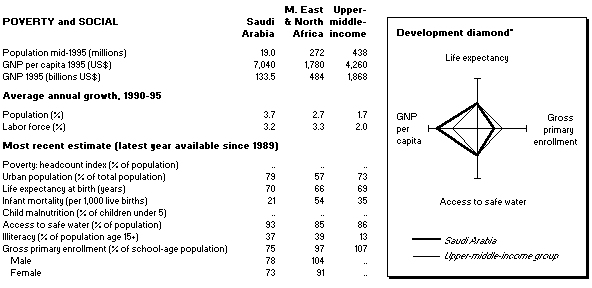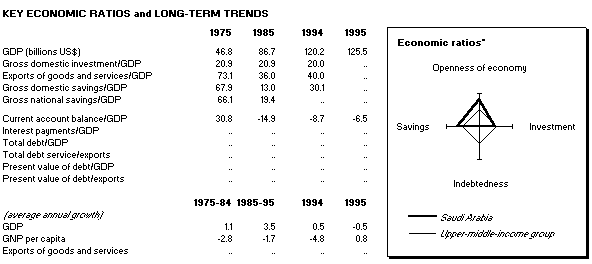|

|
|
|
|
Author -International Finance Corporation
Source: IFS
2121 Pennsylvania Avenue, NW, Washington, DC 20433, USA
Tel: (202) 477-1234 Fax: (202) 974-4396
Saudi Arabia has a population of around 19 million, about two-thirds of whom are Saudis. The growth rate of the population is over 3%, and the demographic structure is very young, with 63% aged under 24 in 1995. At curent population growth rates, the population will have more than doubled by 2020. The prospect of having to find gainful employment for the youth of today weighs heavily on the government. There is an awareness that radical steps must be taken to create the necessary jobs and a concern that if unemployment were to spiral, social unrest could ensue. Education has been a priority for the government. Most educational institutions are administered by the state, with private establishments playing a significant role only at the lower levels. Primary school enrollment remains low by comparison with other upper-middle income countries, with some 75% of the relevant age group was enrolled in primary school education in 1993. The Kingdom has invested heavily in healthcare, and facilities generally have been financed directly by the government through the establishment of hospitals and clinics and by generous incentive and support programs to private-sector institutions. Nonetheless, budgetary constraints, the rapidly growing population and new medical technologies are causing the government to rethink how healthcare will be financed.
The economy is dominated by the petroleum sector which, since the end of the Gulf war in 1992, has contributed an average of nearly 40% of GDP, 75% of government revenues and more than 90% of export receipts. Industrial sector development is based on the ample availability of hydrocarbon resources and is strongly influenced by the development of the oil industry. Oil revenue has been used to develop agriculture and other industries, including iron and steel, construction materials, food processing, engineering, chemicals and metal fabrication. Most of the Kingdom’s commercial oil production to date has taken place in the Eastern Province.
The Saudi government has sought to use oil revenues to finance an ambitious program of infrastructural, industrial and agricultural development, while pursuing a far-reaching program of modernizing the Kingdom’s health and educational systems. The fall in oil prices in the fourth quarter of 1993, combined with IMF concern at the Kingdom’s budget deficit, led the authorities to aim for a balanced budget through a planned 19% reduction in expenditures. In a significant departure from past policies, the domestic prices of petroleum products, electricity, water, telephones, visas and work permits, and air travel were increased significantly, with the intention of reducing reliance of oil revenue. In the sixth Five Year Development Plan (1995-99) the role of the private sector is a particularly important theme. The plan mentions the sale of government assets as a means of rationalizing government expenditures, but does not provide a specific privatization program or timetable for state sales.
The government is now developing a set of initiatives to open up more of the economy to the private sector. A number oof announcements by key miniters in recent months indicate that a wide-ranging economic reform effort is gradually cristalizing. The main initiatives include:
(i) a comprehensive reorganization of the power sector with private sector participation. In late March, Industry & Electricity Minister Hashim Yamani unveiled details of a far-reaching review of the power sector that could lead to the abolition of the four regional Scecos (Saudi Consoldated Electricty Companies) and private sector participation in future entities for generation, transmission, and distribution. Power demand growth is expected to about 4.5 percent a year overr the next 25 years, implying a rise in total electricty demand to 59,000 MW in 2020 from 20,000 MW in 1995. However, because of the need to have a reserve capaicty at peak periods of 17 percent of total generating capacity, Saudi Arabia's power stations will be required to have installed capacity of 65,000 MW by 2020. Some 1,500-2,000 MW will, therefore, have to be added annually over the course of the next 25 years. Implementation of the plan would require investment of SR 48,000 million ($12,000 million) by 2000 and a staggering SR 438,000 million ($116,000 million) by 2020. Clearly the magnitude of the investment is beyond the capabilities of loss-making Scecos and beyonfd the means of the government alone.
(ii) opening up the stock market to non-GCC investors. In one of the most significant decisions affecting the stock market, the Saudi Arabian Monetay Agency (SAMA- central bank) has recently given the go-ahead for the first fund investing in local equities which will be open to non-GCC nationals. Further details of the closed-end Saudi Arabian Investment Fund to be launched by Saudi American Bank (Samba) and listed on the London Stock Exchange are eagerly awaited. The size of the fund, expected to be in the range of $100 million- 250 million, will make very littleimpact on the market as a whole, which is capitalized at about $48,000 million. It is, however, an important first step. Capital market reforms is seen by many as the key to economic reforms. At present only 70 stocks are quoted and many are effectively closed joint-stock compnaies, with large blocks of shares unavailable for trade. The challenge is to create conditions that will bring some of the country's larger family-run compnaies to the market.
(iii) the creation of a new tax code that will remove some of the discrimination against foreign companies. At present, Saudi and GCC nationals pay zakat, a modest wealth tax assessed in proportion to the equity stake of Saudi and GCC nationals in any business. The rate of zakat is 2.5 per cent of capital employed less the amount put into fixed assets, long term investments and deferred costs. Corporate taxes on foreign companies, after a tax holiday for joint ventures, are applied to the portion of income attributable to the foreign partner, excluding GCC nationas. Rates range from 25 percent on the first SR 100,000 to 45 percent on amounts more than SR 1,000,000 ($270,000).
The systematic privatizaion of port operations has already got under way. Acting on recommendations of Seapa (Saudi Seaports Authority), the government has recently approved plans for a systematic programme of privatization that aims to raise productivity levels in the ports by providing grater incentives for private companies to invest in their running. Under the plans, the government will retain ownership of the ports and Seapa will maintain its supervisory role. However, private companies have now starred bidding for 10-year operation, maintenance and management contracts.
Liberalization of the economy is likely to be accelerated by the on-going effort join the Wold Trade Organization (WTO). Joining the WTO should result in freer access to world markets for Saudi oil and petrochemicals exports. It will also entail reviewing the country's entire trade regime. Saudi Arabia is seeking to join as a developing country, which would grant it a grace period of 5-10 years in which to adapt legislation and trading practices. Progress is also expected on liberalization of the financial services sector. The implications for brokerage, insurance and commercial banking activities remain unclear at this stage.
IFC strategy in GCC countries focuses on institution-building in the financial sector to promote financial deepening, efficient resource mobilization and financial intermediations, and financial integration between GCC and other Arab countries. In Saudi Arabia, in particular, there are opportunities for IFC in technical assistance, developing institutions to provide finance to smaller companies, and in establishing a fund for listed and unlisted securities, which would help capital markets development and privatization.
Poverty, Social, and Key Economic Indicators


Source: World Development Indicators, World Bank, February 1997
|
|
|
Send E-mail to
TSN@The-Saudi.Net with questions or
comments about The Saudi Network. We are Looking for Business Sponsorship or Marketing Partnership |